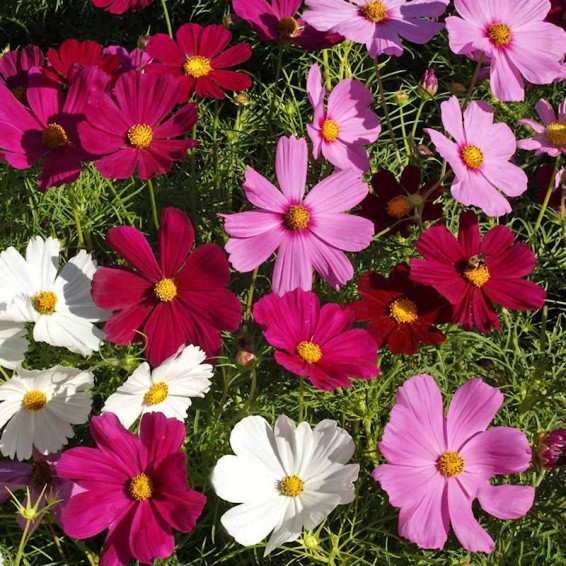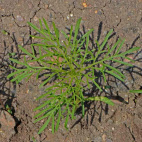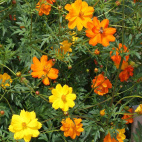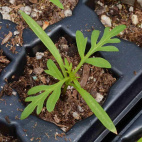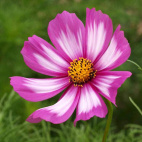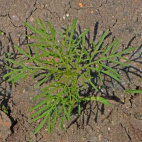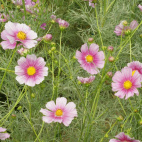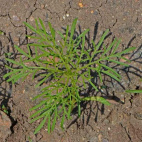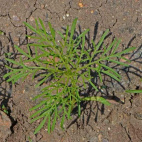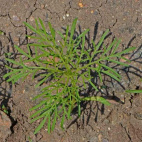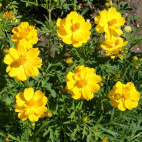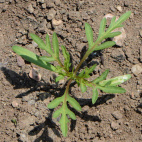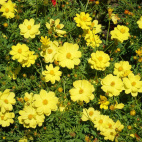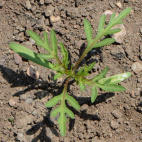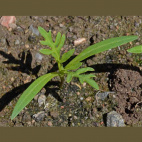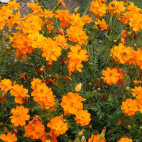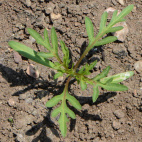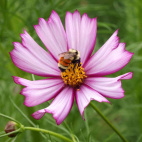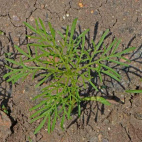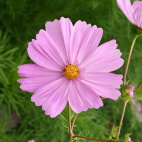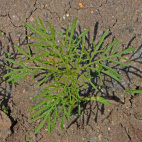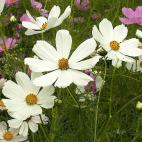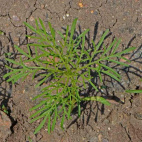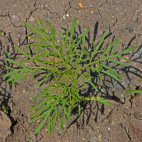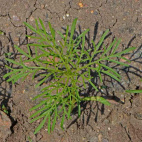Dwarf Cosmos Seed Mix
- HOW TO GROW
- FAST FACTS
- REVIEWS
HOW TO GROW
Sowing: In early spring or after the last frost, scatter the seeds on the surface of loose soil. Keep the soil lightly moist until germination, which should take place within 10-20 days at soil temperatures from 65-75 degrees F. Cooler soil temperatures may delay germination. Seedlings do not need to be thinned, but can be transplanted if they appear too crowded. Since these seeds germinate quickly in warm soil, they can be sown at any time before midsummer for another crop of flowers. To start the seed indoors, sow on the surface of a flat 6-8 weeks before the last frost of spring; keep the soil evenly moist and at a temperature of 70-75 degrees F until germination. When there is no chance of frost, transplant them outdoors.
Growing: Water these dwarf cosmos plants regularly until they begin to bloom; at this point they become quite drought tolerant. This flower must not be over-watered, and grows well in drought conditions and heat; if prolonged drought occurs, give the plants occasional deep watering. The soil does not need to be rich, but it must be well-drained; light shade is tolerated, but will dramatically lessen the amount of blooms.If blooming begins to decrease, cut the plant back to 12" for new growth; more blossoms will come in about 4 weeks. Tall plants may need support or staking. If allowed to self-seed, this flower will produce a new crop of flowers next year. This flower attracts birds, butterflies, and bees.
Harvesting: Dwarf Cosmos flower seeds make lovely, long lasting cut flowers. Cut long stems of blossoms that have just opened, and remove any foliage that will fall below the water level. These flowers usually have a vase life of 7-10 days. Dwarf Cosmos flower seeds also make attractive dried flowers.
Seed Saving: Allow the flowers to drop their petals and develop into spiky seed heads. When ripe, the heads will be brown or dark brown and easily broken apart to reveal the narrow, sharp seeds. Remove the ripe Dwarf Cosmos flower seeds heads and spread them out to dry away from direct sunlight. When they have completely dried, break apart the heads to separate the seeds from the husk. Store the cleaned Dwarf Cosmos flower seeds in a cool, dry place.
FAST FACTS
Common Names: Mexican Aster, Garden Cosmos
Latin Name: Cosmos bipinnatus
Species Origin: Mexico
Type: Garden Flowers
Life Cycle: Annual
USDA Zones: 1, 2, 3, 4, 5, 6, 7, 8, 9, 10, 11, 12
US Regions: California, Mountain, Arid/Desert, Plains/Texas, Midwest, Northern, Northeast, Southeast
Seeds per Ounce: 5,000
Stratification: No Stratification
Germination Ease: No Stratification
Sunlight: Full Sun
Height: 30 Inches
Color: Mixed, White, Pink, Red
Bloom Season: Blooms Late Summer, Blooms Early Fall
Uses: Cut Flowers
Happy customer
Bought 5 different types of seeds- all well packaged and germinated very fast and with a high success rate. /very happy with everything-except usps who took every minute of their 8 days to get it to me, sitting in various stations for multiple days! Very happy with the product tho!
Good value
I'n not new to bulk seed, but I'm new to Everwilde. The value is good, the seed looks very clean and the packaging is impressive. I'm in the habit of splitting my plantings between two seasons, but the paper or cloth packages I'm used to make storage difficult. These packages are perfect for people like me!
Look great
I've only got the lught punk blooming though. I thought it would be a mixture. They look great though!
Seeds!!!
I have purchased seeds from Everwilde for several years with much success!I love seeing the beautiful sunflowers after they bloom and being able to cut and enjoy inside the house. I highly recommend these products.
Flower Bloom Excitement !
Spring is here and I am looking forward to seeing my gorgeous
'Dwarf Cosmos Mixed Seed Mix Bloom again. I ordered the 'Cosmos Mix'
last year and was astonished at how beautiful they were and they last until the first frost. I am going to order them every year to beautify my garden!
Sincerely,
Satisfied Customer,
Rennee Hochstadt
Dwarf Cosmos
My Dwarf Cosmos in 2020 were extraordinary! They had challenging growing conditions and yet germination, vigor and flower exceeded my hopes!
Shipping took too long
Shipping took too long especially for only 2 envelopes of seeds. I ordered these seeds from your company, rather then another, because I needed them by a certain date and they did not arrive until after the date they were supposed to. Also, shipping cost for 2 small packs of seeds was too expensive. I could have had them shipped by amazon.com for free, but as I said I ordered from your company instead because I needed them by a specific date and despite what was advertised as the expected date of receipt, they did not arrive on time. Very disappointing especially considering my options for purchase elsewhere.
We are sorry that these took a while to arrive. The seeds shipped right out the day after it was ordered, but then the Post Office took a while to get it to you. We have seen quite a few shipping delays because of the current pandemic, and wish there was something that we could do about it.
Dwarf cosmos
Seeds were well-stocked and arrived in just a few days. Website was easy to navigate.
dwarf cosmos seeds
Looks great!
Cosmos and zinnia seeds
Fast shipping in great packaging haven't planted them yet but they look like great quality seeds
DESCRIPTION
-Distribution-Map.jpg)
HOW TO GROW
Sowing: In early spring or after the last frost, scatter the seeds on the surface of loose soil. Keep the soil lightly moist until germination, which should take place within 10-20 days at soil temperatures from 65-75 degrees F. Cooler soil temperatures may delay germination. Seedlings do not need to be thinned, but can be transplanted if they appear too crowded. Since these seeds germinate quickly in warm soil, they can be sown at any time before midsummer for another crop of flowers. To start the seed indoors, sow on the surface of a flat 6-8 weeks before the last frost of spring; keep the soil evenly moist and at a temperature of 70-75 degrees F until germination. When there is no chance of frost, transplant them outdoors.
Growing: Water these dwarf cosmos plants regularly until they begin to bloom; at this point they become quite drought tolerant. This flower must not be over-watered, and grows well in drought conditions and heat; if prolonged drought occurs, give the plants occasional deep watering. The soil does not need to be rich, but it must be well-drained; light shade is tolerated, but will dramatically lessen the amount of blooms.If blooming begins to decrease, cut the plant back to 12" for new growth; more blossoms will come in about 4 weeks. Tall plants may need support or staking. If allowed to self-seed, this flower will produce a new crop of flowers next year. This flower attracts birds, butterflies, and bees.
Harvesting: Dwarf Cosmos flower seeds make lovely, long lasting cut flowers. Cut long stems of blossoms that have just opened, and remove any foliage that will fall below the water level. These flowers usually have a vase life of 7-10 days. Dwarf Cosmos flower seeds also make attractive dried flowers.
Seed Saving: Allow the flowers to drop their petals and develop into spiky seed heads. When ripe, the heads will be brown or dark brown and easily broken apart to reveal the narrow, sharp seeds. Remove the ripe Dwarf Cosmos flower seeds heads and spread them out to dry away from direct sunlight. When they have completely dried, break apart the heads to separate the seeds from the husk. Store the cleaned Dwarf Cosmos flower seeds in a cool, dry place.
FAST FACTS
Common Names: Mexican Aster, Garden Cosmos
Latin Name: Cosmos bipinnatus
Species Origin: Mexico
Type: Garden Flowers
Life Cycle: Annual
USDA Zones: 1, 2, 3, 4, 5, 6, 7, 8, 9, 10, 11, 12
US Regions: California, Mountain, Arid/Desert, Plains/Texas, Midwest, Northern, Northeast, Southeast
Seeds per Ounce: 5,000
Stratification: No Stratification
Germination Ease: No Stratification
Sunlight: Full Sun
Height: 30 Inches
Color: Mixed, White, Pink, Red
Bloom Season: Blooms Late Summer, Blooms Early Fall
Uses: Cut Flowers
Reviews
Review
Happy customer
Bought 5 different types of seeds- all well packaged and germinated very fast and with a high success rate. /very happy with everything-except usps who took every minute of their 8 days to get it to me, sitting in various stations for multiple days! Very happy with the product tho!
Review
Good value
I'n not new to bulk seed, but I'm new to Everwilde. The value is good, the seed looks very clean and the packaging is impressive. I'm in the habit of splitting my plantings between two seasons, but the paper or cloth packages I'm used to make storage difficult. These packages are perfect for people like me!
Review
Look great
I've only got the lught punk blooming though. I thought it would be a mixture. They look great though!
Review
Seeds!!!
I have purchased seeds from Everwilde for several years with much success!I love seeing the beautiful sunflowers after they bloom and being able to cut and enjoy inside the house. I highly recommend these products.
Review
Flower Bloom Excitement !
Spring is here and I am looking forward to seeing my gorgeous
'Dwarf Cosmos Mixed Seed Mix Bloom again. I ordered the 'Cosmos Mix'
last year and was astonished at how beautiful they were and they last until the first frost. I am going to order them every year to beautify my garden!
Sincerely,
Satisfied Customer,
Rennee Hochstadt
Review
Dwarf Cosmos
My Dwarf Cosmos in 2020 were extraordinary! They had challenging growing conditions and yet germination, vigor and flower exceeded my hopes!
Review
Shipping took too long
Shipping took too long especially for only 2 envelopes of seeds. I ordered these seeds from your company, rather then another, because I needed them by a certain date and they did not arrive until after the date they were supposed to. Also, shipping cost for 2 small packs of seeds was too expensive. I could have had them shipped by amazon.com for free, but as I said I ordered from your company instead because I needed them by a specific date and despite what was advertised as the expected date of receipt, they did not arrive on time. Very disappointing especially considering my options for purchase elsewhere.
We are sorry that these took a while to arrive. The seeds shipped right out the day after it was ordered, but then the Post Office took a while to get it to you. We have seen quite a few shipping delays because of the current pandemic, and wish there was something that we could do about it.
Review
Dwarf cosmos
Seeds were well-stocked and arrived in just a few days. Website was easy to navigate.
Review
dwarf cosmos seeds
Looks great!
Review
Cosmos and zinnia seeds
Fast shipping in great packaging haven't planted them yet but they look like great quality seeds
Also Consider These:
-
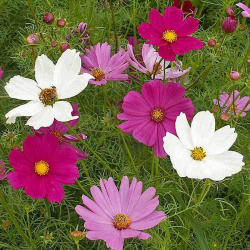 Sensation Tall Cosmos Seed Mix
Cosmos bipinnatus
Quick View
x
Sensation Tall Cosmos Seed Mix
Cosmos bipinnatus
Quick View
xSensation Tall Cosmos Seed Mix
Starting at $3.48 USD -
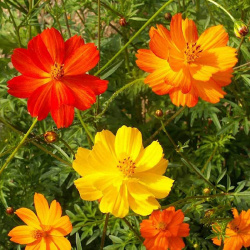 Bright Lights Sulphur Cosmos Seed Mix
Cosmos sulphureus
Quick View
x
Bright Lights Sulphur Cosmos Seed Mix
Cosmos sulphureus
Quick View
xBright Lights Sulphur Cosmos Seed Mix
Starting at $3.48 USD -
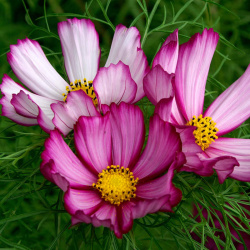 Candystripe Cosmos Seeds
Cosmos bipinnatus
Quick View
x
Candystripe Cosmos Seeds
Cosmos bipinnatus
Quick View
xCandystripe Cosmos Seeds
Starting at $3.48 USD -
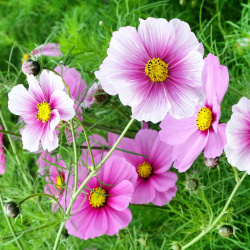 Daydream Cosmos Seeds
Cosmos bipinnatus
Quick View
x
Daydream Cosmos Seeds
Cosmos bipinnatus
Quick View
xDaydream Cosmos Seeds
Cosmos bipinnatus
These pale, dreamy blossoms blush pink toward the center and are a magnet for wandering butterflies. This species is an easy-to-grow annual that will dress up your flower garden, or grace your table in a flower vase. Add other beautiful cosmos flower seeds to your home garden!
Starting at $3.48 USD -
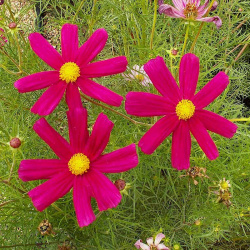 Dazzler Cosmos Seeds
Cosmos bipinnatus
Quick View
x
Dazzler Cosmos Seeds
Cosmos bipinnatus
Quick View
xDazzler Cosmos Seeds
Starting at $3.48 USD -
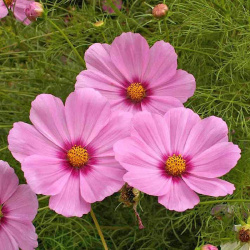 Gloria Cosmos Seeds
Cosmos bipinnatus
Quick View
x
Gloria Cosmos Seeds
Cosmos bipinnatus
Quick View
xGloria Cosmos Seeds
Starting at $3.48 USD -
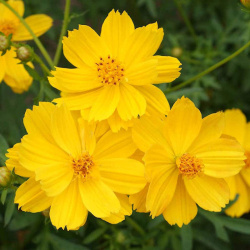 Dwarf Gold Sulphur Cosmos Seeds
Cosmos sulphureus
Quick View
x
Dwarf Gold Sulphur Cosmos Seeds
Cosmos sulphureus
Quick View
xDwarf Gold Sulphur Cosmos Seeds
Starting at $3.48 USD -
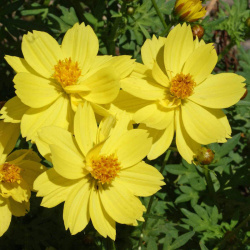 On Sale!
Dwarf Lemon Sulphur Cosmos Seeds
Cosmos sulphureus
Quick View
x
On Sale!
Dwarf Lemon Sulphur Cosmos Seeds
Cosmos sulphureus
Quick View
xDwarf Lemon Sulphur Cosmos Seeds
Cosmos sulphureus
Yellow flowers glimmer on this dwarf Cosmos variety. Mixing this variety with some of the other dwarf cosmos types gives a pleasing effect. This easy-to-grow annual is pretty care-free but blooms all summer long.
Starting at $3.48 USD -
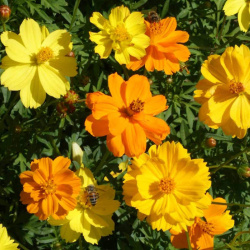 Dwarf Sulphur Cosmos Seed Mix
Cosmos sulphureus
Quick View
x
Dwarf Sulphur Cosmos Seed Mix
Cosmos sulphureus
Quick View
xDwarf Sulphur Cosmos Seed Mix
Starting at $3.48 USD -
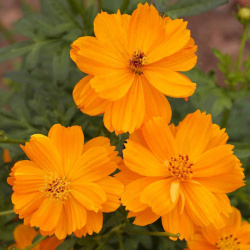 On Sale!
Dwarf Orange Sulphur Cosmos Seeds
Cosmos sulphureus
Quick View
x
On Sale!
Dwarf Orange Sulphur Cosmos Seeds
Cosmos sulphureus
Quick View
xDwarf Orange Sulphur Cosmos Seeds
Cosmos sulphureus
This dwarf Cosmos variety showcases vivid, orange blossoms. It is a great annual wildflower choice for butterfly enthusiasts and cut flower connoisseurs alike. Very easy to grow and great for beginning gardeners.
Starting at $3.48 USD -
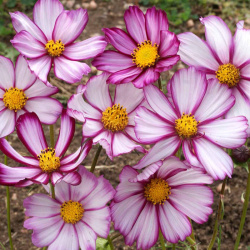 Picotee Cosmos Seeds
Cosmos bipinnatus
Quick View
x
Picotee Cosmos Seeds
Cosmos bipinnatus
Quick View
xPicotee Cosmos Seeds
Cosmos bipinnatus
This beauty boasts pure white flowers edged with rosy pink to magenta, making it a specialty Cosmos variety. It looks refined and fussy but really takes very little care or effort to keep it happy. It is an annual and is very easy to grow, so it makes a great starter plant if you are new to seeds.
Starting at $3.48 USD -
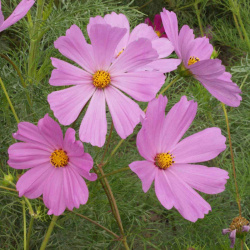 On Sale!
Pinkie Cosmos Seeds
Cosmos bipinnatus
Quick View
x
On Sale!
Pinkie Cosmos Seeds
Cosmos bipinnatus
Quick View
xPinkie Cosmos Seeds
Cosmos bipinnatus
This lovely variety blooms a cotton candy pink with soft yellow centers. The butterflies think that it is a beautiful flower too. Moreover, it is easy to grow, so is there any reason that it should not be in your garden?
Starting at $3.48 USD -
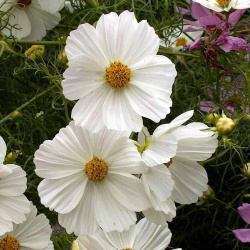 Purity Cosmos Seeds
Cosmos bipinnatus
Quick View
x
Purity Cosmos Seeds
Cosmos bipinnatus
Quick View
xPurity Cosmos Seeds
Starting at $3.48 USD -
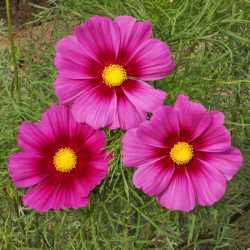 Radiance Cosmos Seeds
Cosmos bipinnatus
Quick View
x
Radiance Cosmos Seeds
Cosmos bipinnatus
Quick View
xRadiance Cosmos Seeds
Starting at $3.48 USD -
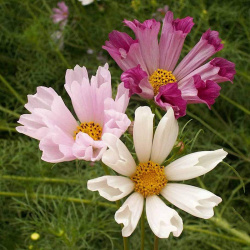 Sea Shells Cosmos Seeds
Cosmos bipinnatus
Quick View
x
Sea Shells Cosmos Seeds
Cosmos bipinnatus
Quick View
xSea Shells Cosmos Seeds
Starting at $3.48 USD -
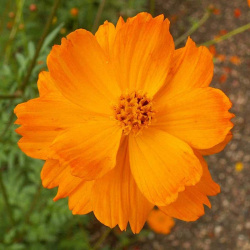 On Sale!
Tall Orange Sulphur Cosmos Seeds
Cosmos sulphureus
Quick View
x
On Sale!
Tall Orange Sulphur Cosmos Seeds
Cosmos sulphureus
Quick View
xTall Orange Sulphur Cosmos Seeds
Starting at $3.48 USD -
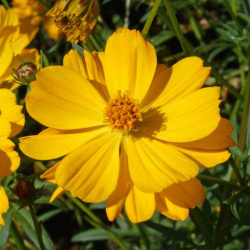 Tall Yellow Sulphur Cosmos Seeds
Cosmos sulphureus
Quick View
x
Tall Yellow Sulphur Cosmos Seeds
Cosmos sulphureus
Quick View
xTall Yellow Sulphur Cosmos Seeds
Starting at $3.48 USD
